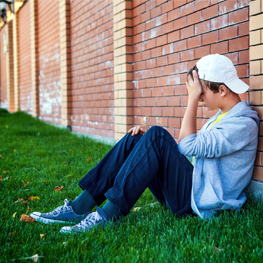
How we talk about suicide with our kids is fraught with misconceptions. But as difficult as these conversations might be, our willingness to listen and be direct with our children can mean the difference between life and death.
According to The Jason Foundation, suicide is the third leading cause of death among 10 to 14 year olds and has increased among this age group by more than 150 percent since 1981. For middle school and high school students, it’s the second leading cause of death.
Here are six common myths about discussing suicide with kids of all ages.
Myth: Talking to kids about suicide gives them ideas.
Fact: Talking to kids about suicide is one of the best ways to prevent it. If you’re concerned that your adolescent might be contemplating suicide, ask the question point-blank: “Are you thinking about killing yourself?”
“Many are relieved that someone finally asked this question,” says high school counselor Kimberly Urenda. “After asking, listen. Don’t judge. Don’t act shocked.”
Avoid minimizing their feelings by saying things like, “Oh, you don’t really feel that way” or, “You’re just sad.”
“Tell them you care about them, you love them, and you will get them help,” advises Urenda.
Seek support from a school counselor or another mental health professional.
Myth: Suicide is something you shouldn’t talk about with younger children.
Fact: While the subject isn’t an easy one to discuss, “I believe you should always be honest and open with any age,” says school counselor Carl Crabtree.
If a suicide occurs or is attempted by someone in your family and your youngster only overhears bits and pieces, you’ll miss a teachable moment. “The child constructs what happened silently without support and a family secret is born,” says Crabtree.
Keep the conversation simple and hopeful with younger children. Answer questions and listen. “In our answers, we should avoid blame and guilt, avoid clichés, and focus on the feelings,” advises Crabtree. For example, describe someone who attempts or completes suicide as “sick in their feeling.”
“‘Sick’ is a word that children can understand. Also, it opens the door of thinking for children, knowing when we are sick, we go to a doctor to get well,” explains Crabtree. During the conversation, discuss what we can do and who we can specifically talk to if we’re feeling sad, angry, anxious, or unhappy.
Myth: Suicide only happens to depressed kids.
Fact: There is no single cause for suicide. Usually suicide is the result of a combination of issues that can range from stress and bullying, isolation, abuse, social media, puberty and family genetics to drug and alcohol abuse.
“The level of an individual’s impulsivity is another risk factor, especially in teens,” says Crabtree.
LGBTQ kids are particularly at risk. According to the Trevor Project, the rate of suicide attempts is four times greater for LGB youth than that of straight youth.
“One of the reasons is a lack of acceptance and support by others, sometimes including their families,” says Deb Woodard, associate adjunct teaching professor and school counseling coordinator for the University of Missouri-Kansas City. “The best thing that families can do is to educate themselves and then have honest and supportive conversations with their children.”
Myth: I can’t prevent suicide by talking to my child. Suicide happens without warning.
Fact: Suicide is preventable. Knowing the signs and keeping the lines of communication open with your child is important. Encourage your adolescent to let an adult know if they notice a peer posting messages on social media that indicate they might end their life.
Take time to connect as a family and with your kids individually. Play video or board games together, bike ride, take a walk, or shop together. Conversation and worries often pour out during less intense, companionable moments.
Keep an eye on your teen if a close friend or a classmate commits suicide. Seek professional grief counseling or mental health support for your child to help them process the death.
“Many times, people are searching for a ‘why’ and often lash out at others or blame them. This can be difficult if your child feels they are the ‘cause’ of the suicide,” says Urenda.
Sometimes the outpouring of grief and attention on the victim can spark copycat suicides. Monitor your child’s eating, sleep and self-care patterns, social media posts, and ask them if they are contemplating suicide.
Myth: I shouldn’t take it too seriously when my child comes home from school and says they wish they were dead. All kids say stuff like that - they just had a bad day, right?
Fact: Maybe. Maybe not. While your initial reaction might be to say, “Don’t talk like that,” Crabtree recommends pursuing the conversation.
“Say, ‘Tell me why’ and then listen,” he advises. “This would be an excellent example of a chance to teach your child coping skills.”
If this pattern continues, visit a licensed counsellor or psychologist.
Myth: I’ve talked to my child about suicide; I think they get it.
Fact: The truth is, these aren’t one-time conversations. Use books, movies, and TV shows to highlight individuals who persevere even under unimaginable conditions. Share your own stories and challenges. Remind your kids that you love and support them. And, even though life can sometimes seem unbearable, it always gets better.
Suicide warning signs:
Source: The Jason Foundation
Factors that can strengthen a child’s resilience to suicide include:
Source: National Association of School Psychologists
Freelance journalist Christa and her husband are the parents of two sons. Her latest book is Happy, Healthy & Hyperconnected: Raise a Thoughtful Communicator in a Digital World.
Calgary’s Child Magazine © 2024 Calgary’s Child